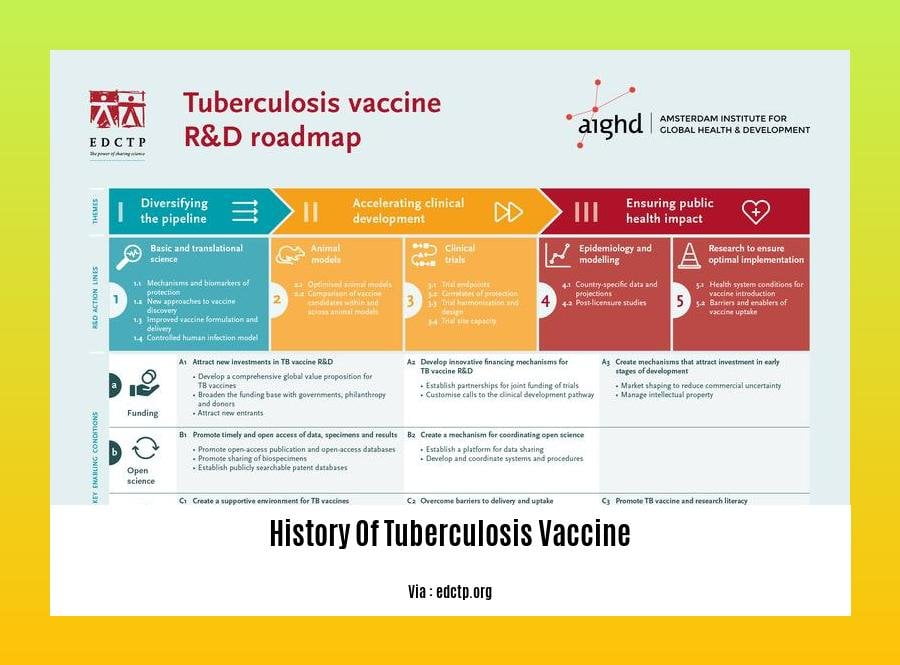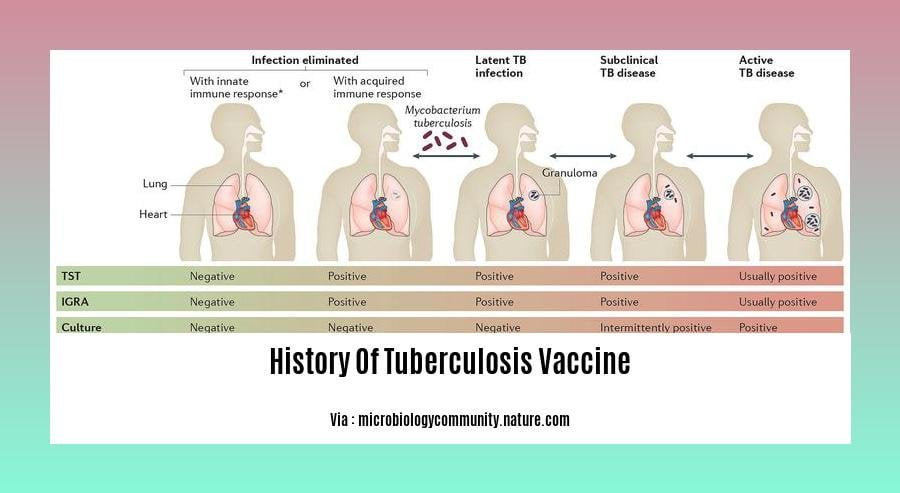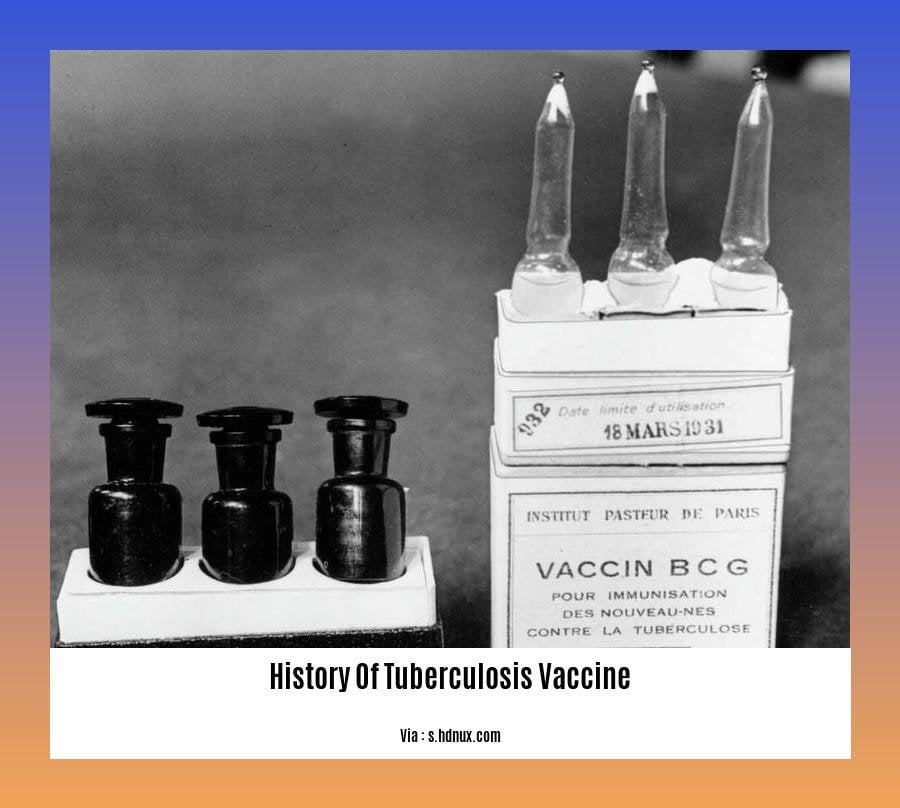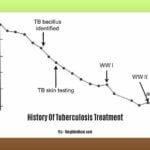Embark on a captivating journey through time as we delve into the remarkable history of the tuberculosis vaccine—a testament to medical triumph and perseverance. From the initial breakthroughs to the challenges faced and overcome, this story unveils the unwavering dedication of scientists and healthcare professionals in their quest to conquer a devastating disease that has plagued humanity for centuries. Prepare to be inspired by the resilience of the human spirit as we witness the evolution of the tuberculosis vaccine, a true beacon of hope in the fight against infectious diseases. [- Delving into the History of Tuberculosis Vaccine: A Journey of Medical Triumph and Perseverance].
Key Takeaways:
Tuberculosis (TB) vaccines aim to prevent TB, a leading cause of death from infectious diseases worldwide.
German physician, Robert Koch, was the first to identify Mycobacterium tuberculosis as the cause of TB in the 19th century.
Bacillus Calmette-Guérin (BCG) is the only effective and widely used TB vaccine. It contains weakened cattle tuberculosis strains.
BCG vaccination is usually given to newborns in countries where TB is common.
Research is ongoing to develop new TB vaccines that are more effective, protect against a broader range of TB strains, and require fewer doses.
History of Tuberculosis Vaccine

In the realm of infectious diseases, tuberculosis (TB) stands as a formidable foe, claiming countless lives worldwide. The advent of vaccines has revolutionized our fight against TB, offering a beacon of hope in preventing this devastating disease. Join us as we embark on a journey through time, delving into the History of Tuberculosis Vaccine, a testament to medical triumph and perseverance.
Mycobacterium Tuberculosis: Unveiling the Culprit
The story begins in the 19th century, when German physician Robert Koch made a groundbreaking discovery. He identified Mycobacterium tuberculosis as the insidious agent responsible for TB, unveiling the hidden enemy lurking within. This revelation marked a pivotal moment, propelling the quest for an effective vaccine against this deadly pathogen.
Birth of the BCG Vaccine: A Legacy of Protection
Bacillus Calmette-Guérin (BCG), the first and still widely used TB vaccine, emerged as a beacon of hope in the early 20th century. Developed by Albert Calmette and Camille Guérin, this ingenious vaccine utilized attenuated cattle tuberculosis strains, offering a safe and effective means of immunization.
BCG Vaccination: A Global Shield
The BCG vaccine has become a cornerstone of TB prevention, particularly in regions with a high prevalence of the disease. Administered primarily to newborns, this single shot has proven remarkably effective in reducing the risk of severe TB forms, particularly in children. Its impact has been nothing short of profound, saving countless lives and preventing untold suffering.
Ongoing Quest for Improved TB Vaccines
While the BCG vaccine has undoubtedly made significant strides in curbing TB, the relentless nature of the disease demands continued innovation. Scientists worldwide are tirelessly pursuing the development of new TB vaccines, driven by the unwavering goal of enhanced efficacy, broader protection, and streamlined vaccination schedules.
The Future of TB Vaccines: A Glimmer of Hope
The future of TB vaccines holds immense promise. Novel approaches, such as recombinant vaccines, subunit vaccines, and DNA vaccines, are undergoing rigorous evaluation, demonstrating encouraging results in clinical trials. These advancements offer a glimmer of hope, propelling us closer to a world free from the scourge of tuberculosis.
Conclusion: A Collective Triumph
The History of Tuberculosis Vaccine is a testament to the unwavering dedication of scientists, researchers, and healthcare professionals. Their relentless pursuit of knowledge and unwavering commitment to human health have led to the development of life-saving vaccines, transforming the fight against TB. As we continue to push the boundaries of medical science, we can look forward to a future where TB is a relic of the past.
If you’re curious about the progression of tuberculosis through time, click on history of tuberculosis to learn more about its chronological evolution.
Are you interested in understanding the medical classification of tuberculosis? Explore the History Of Tuberculosis Icd 10 page to discover its official disease code.
If you’re seeking information about managing tuberculosis, History Of Tuberculosis Treatment provides comprehensive details on its historical treatment approaches.
To delve into the prevalence of tuberculosis within the United States, uncover the fascinating history behind its impact by clicking on History Of Tuberculosis In The United States.
If you’re intrigued by the historical presence of tuberculosis in Africa, embark on a journey through History Of Tuberculosis In Africa to uncover its profound influence on the continent.
Development of the BCG vaccine by Albert Calmette and Jean-Marie Guérin and its initial trials

In the early 20th century, tuberculosis (TB) ravaged communities worldwide, leaving a trail of devastation and claiming countless lives. Amid this global health crisis, two brilliant scientists, Albert Calmette and Jean-Marie Guérin, embarked on a pioneering journey to develop a vaccine that would change the course of history. Their unwavering dedication and relentless pursuit of medical triumph led to the creation of the BCG vaccine, a beacon of hope in the fight against TB.
Key Takeaways:
The BCG vaccine, a brainchild of Albert Calmette and Jean-Marie Guérin, stands as the first and most widely used TB vaccine globally.
Developed over a span of 13 years, from 1908 to 1921, the BCG vaccine emerged as a testament to their unwavering commitment to scientific progress.
The vaccine, named after its creators, Bacillus Calmette-Guérin (BCG), was first administered in 1921, marking a pivotal moment in the battle against TB.
Mass production of the BCG vaccine commenced in 1924, making it widely accessible and heralding a new era of TB prevention.
The BCG vaccine offers partial protection against TB, particularly its severe forms, providing a crucial shield for vulnerable populations.
Largely considered safe, with minimal side effects, the BCG vaccine has been instrumental in reducing the burden of TB, saving countless lives.
References:
Widespread use of the BCG vaccine in the 20th century and its effectiveness in reducing tuberculosis incidence
Hey there, health enthusiasts! Are y’all ready to delve into the captivating history of the tuberculosis vaccine? In this riveting journey, we’ll explore the groundbreaking work of dedicated scientists who developed and implemented the BCG vaccine, a significant milestone in the fight against this deadly disease.
Key Takeaways:
A Lifesaving Discovery: The BCG vaccine, developed by visionary scientists Albert Calmette and Camille Guérin, marked a turning point in the battle against tuberculosis, offering a glimmer of hope for millions worldwide.
A Global Embrace: The BCG vaccine rapidly gained widespread acceptance, becoming an integral part of immunization programs in countries across the globe. The vaccine’s effectiveness in reducing severe forms of tuberculosis, particularly among vulnerable children, propelled its adoption as a cornerstone of public health efforts.
A Beacon of Hope: The successful implementation of the BCG vaccine in the 20th century is a testament to the resilience and ingenuity of scientists, healthcare professionals, and global health organizations. Their collective efforts saved countless lives and continue to inspire hope for a TB-free future.
A Continued Legacy: While the BCG vaccine remains a crucial tool in the fight against tuberculosis, researchers are tirelessly pursuing the development of even more effective vaccines. The quest for a next-generation TB vaccine holds immense promise for eradicating this devastating disease.
I hope you found this journey through the history of the tuberculosis vaccine both informative and inspiring. Remember, folks, the fight against disease is an ongoing battle, and your continued support for research and public health initiatives is vital in ensuring a healthier future for all.
Sources:
Challenges in the vaccination against tuberculosis, including the emergence of drug-resistant strains
Key Takeaways:
- Persistent Threat: Despite scientific progress, the development of an effective TB vaccine remains a complex and challenging endeavor.
- Unique Challenges: The characteristics of M. tuberculosis, including its intracellular lifestyle and complex immune response, pose obstacles in vaccine design.
- Ensuring Safety and Efficacy: The safety and efficacy of new vaccine candidates, especially in vulnerable populations, are paramount.
- Promising Advances: New vaccine candidates are undergoing clinical trials, including subunit vaccines, viral-vectored vaccines, and whole-cell vaccines.
- Focus on Immune Responses: Vaccine development targets the induction of protective immune responses, including cell-mediated immunity and humoral immunity.
- Complementary Approach: Effective vaccines are a critical goal, but they complement comprehensive TB control measures like early diagnosis, treatment, and infection prevention.
The development of a universally effective tuberculosis (TB) vaccine is a pressing need given the global TB burden and the emergence of drug-resistant strains. While significant progress has been made, several challenges hinder the development of a successful vaccine.
One challenge lies in the unique characteristics of M. tuberculosis. The bacterium’s ability to persist inside host cells and the complex immune response it elicits make vaccine design difficult. Additionally, ensuring the safety and efficacy of new vaccine candidates, particularly in vulnerable populations, is crucial.
Despite these challenges, there have been promising advances in TB vaccine development. New vaccine candidates, such as subunit vaccines, viral-vectored vaccines, and whole-cell vaccines, are undergoing clinical trials. These candidates aim to induce robust immune responses, including cell-mediated immunity and humoral immunity, against M. tuberculosis.
While the development of an effective TB vaccine is a primary goal, it is essential to recognize that vaccines alone cannot eliminate TB. Comprehensive TB control measures, including early diagnosis, treatment, and infection prevention, remain vital in reducing the incidence and spread of the disease.
Relevant Sources:
[1] World Health Organization: https://www.who.int/news-room/fact-sheets/detail/tuberculosis
[2] Centers for Disease Control and Prevention:
FAQ
Q1: What are the earliest efforts in developing a vaccine for tuberculosis?
A1: In the late 19th century, Robert Koch’s discovery of Mycobacterium tuberculosis as the causative agent of TB paved the way for vaccine development. Albert Calmette and Camille Guérin dedicated 13 years to research and experimentation, culminating in the creation of the Bacillus Calmette-Guérin (BCG) vaccine in 1921.
Q2: How did the BCG vaccine come to be widely used?
A2: The first BCG vaccination was administered in Paris in 1921, and mass production began in 1924. Its effectiveness in preventing severe forms of tuberculosis led to its widespread adoption in many countries, becoming one of the most widely used vaccines globally.
Q3: What are the challenges in developing a more effective tuberculosis vaccine?
A3: Despite the success of the BCG vaccine, there is still a need for a more effective vaccine that can provide broader protection and overcome the challenges posed by drug-resistant strains of TB. The unique characteristics of Mycobacterium tuberculosis, including its intracellular lifestyle and complex immune response, present obstacles in vaccine design.
Q4: What are some promising new approaches in tuberculosis vaccine development?
A4: Researchers are exploring novel approaches to improve vaccine efficacy. These include subunit vaccines, viral-vectored vaccines, and whole-cell vaccines. Additionally, mRNA vaccines and immunomodulatory strategies are being investigated to enhance the immune response and provide better protection against tuberculosis.
Q5: How does vaccination against tuberculosis fit into comprehensive TB control strategies?
A5: Vaccination is an essential component of TB control, working synergistically with other measures such as early diagnosis, treatment, and infection prevention. While an effective vaccine remains a critical goal, comprehensive TB control strategies are necessary to reduce the incidence and spread of the disease, especially in vulnerable populations.
- Crypto Quotes’ Red Flags: Avoid Costly Mistakes - June 30, 2025
- Unlock Inspirational Crypto Quotes: Future Predictions - June 30, 2025
- Famous Bitcoin Quotes: A Deep Dive into Crypto’s History - June 30, 2025
















